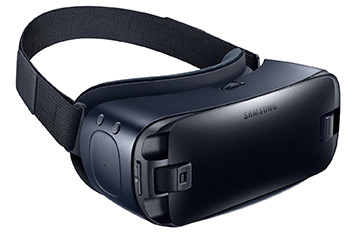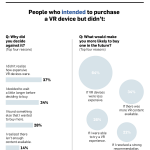VR’s Distribution Problem
VR’s Distribution Problem
by Josh Engroff, Op-Ed Contributor, February 10, 2017

This post was previously published in an earlier edition of Online Spin.
Remember the smartphone platform wars? Back when you actually had to think for more than five minutes when choosing which new phone to buy, because there was a whole bunch of options — Blackberry, Nokia, Microsoft, Android, iPhone — each with its own platform and handsets?
For a period, that abundance of choice created a real conundrum for app developers, since, unlike on the Web where you could “write once, run anywhere,” on smartphones it was “write once, run on only one OS.” And so, rather than creating OS-specific versions of the same app for Blackberry OS, Symbian, Windows Mobile, Android, iOS, most developers just focused on the last two.
And the rest, as they say, is history. We know who won that particular platform war. When it comes to simplifying consumer choice, duopolies can be quite convenient.
As young as it is, the VR hardware industry seems headed into similar territory. The Oculus Rift, HTC Vive, Samsung Gear VR, and Sony Playstation VR are separate systems with their own specs, and there is no guarantee that applications and content developed for one platform will run on another. Not to mention AR platforms like Magic Leap and Microsoft HoloLens.
This creates a major distribution challenge for VR app developers, and content creators, and brands seeking marketing opportunities within these new experiences.
To be clear, by “VR” I do not mean “360 video.” The two are not the same. Done well, true VR (Toy Box as experienced on Oculus, say) is so completely immersive that the human brain perceives itself to be physically present in this new world. The experience can be sublimely awe-inspiring, highly personal, and deeply emotional.
With its ability to transport you to worlds you wouldn’t otherwise visit (war-torn Syria, for example), VR has been called “the ultimate empathy machine.” At this point, anyone who still believes VR to be a gimmick probably hasn’t tried it.
But these experiences come at a cost, because VR is rewriting the rules of video game design and movie-making. Pre-VR, content was all designed for screens that are some distance away from our faces — whether movie, TV or smartphone — and don’t port well to VR. In fact, bad VR experiences can easily make you vomit, as Josh Lovison wrote recently in VR insider.
And so companies large and small are rushing to create new content specific to the platform. Media companies currently developing content for VR, or investing in it, include The New York Times, Conde Nast, Vice Media, Discovery Communications, HBO (invested in Otoy), Disney (Jaunt), and Comcast (NextVR). And to the extent this new content is advertising-supported, marketers will follow.
Which brings us back to the problem of distribution. No company wants to spend millions of dollars on VR content to find that it only works on one of many possible devices. Many companies, and not just content creators, cite their biggest barrier to doing VR as having to choose which piece of hardware to distribute on.
This suggests that, over the next couple of years, individual media companies and marketers will end up taking one of three avenues when it comes to VR:
1. Invest heavily in VR content for a year or two, without full awareness of the challenges around distribution, user adoption, and specific creative parameters native to the device. In this scenario, proving ROI becomes difficult, frustration mounts, and budgets get cut.
2. Forego VR for now, and focus on developing AR experiences instead, where the smartphone is the platform and Android and iOS are already well understood. This means a lot of 360 video, but also some truly innovative new experiences, as we’ve seen with Pokemon Go.
3. Invest in VR now — after all, which marketer doesn’t want access to consumers inside an “ultimate empathy machine”? — but with eyes wide open, clearly cognizant of the challenges. Take the long view on ROI and find partners, like EntryPoint and Immersv, to help with distribution and monetization.
As an investor, I’m very focused on avenue 3, particularly those startups developing infrastructure to help big media companies and brands clear the structural hurdles of VR.
As a media strategist, I think avenue 2 contains more near-term opportunity for most brands, especially since great marketing opportunities within great AR experiences already exist (Snapchat).
Avenue 1, as you might imagine, is one path I’d advise against.
MediaPost.com: Search Marketing Daily
(47)












